Enhancing sport and physical activity participation for Canadians with disabilities
July 25, 2022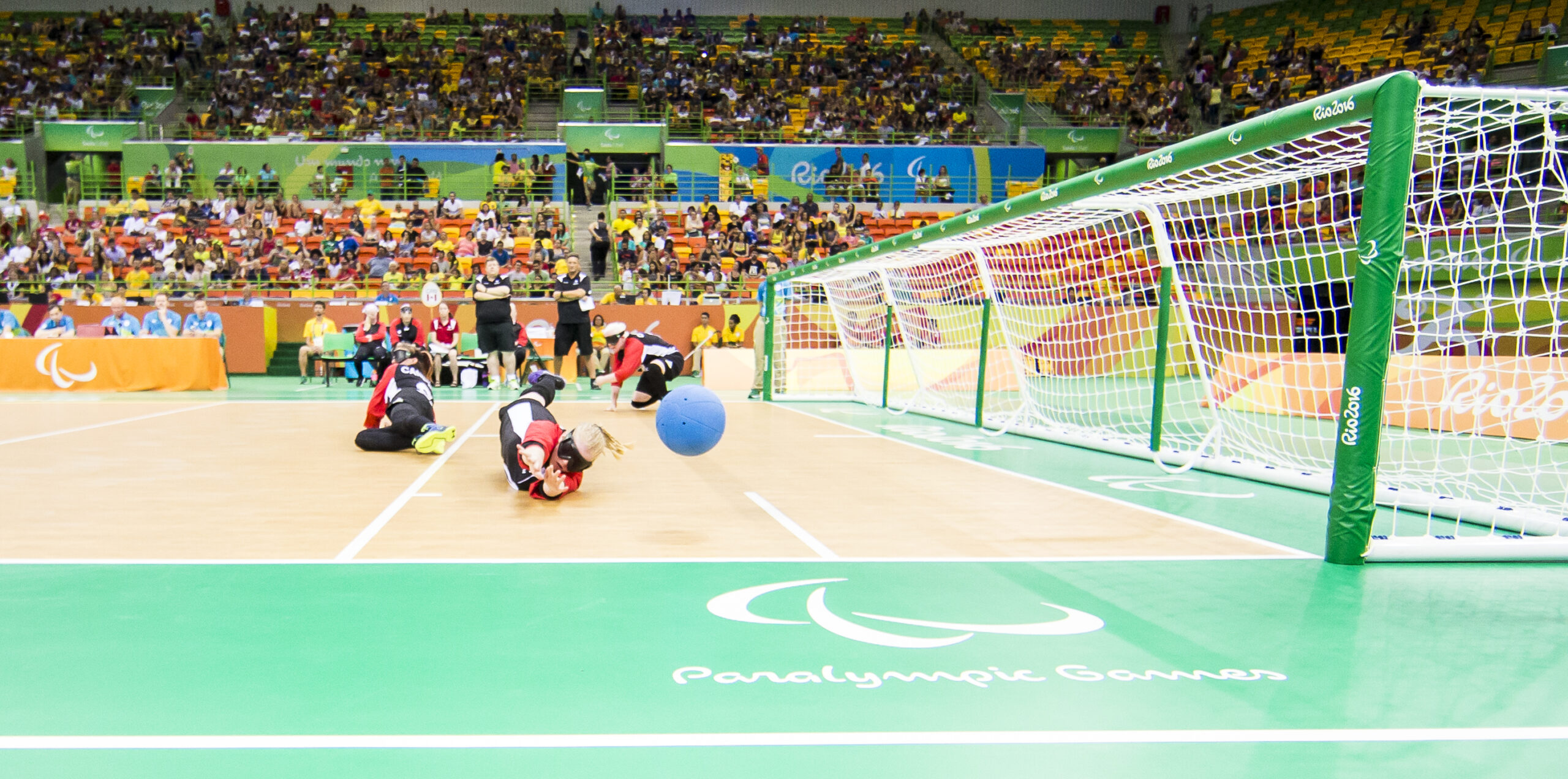
Highlights
- This article provides an overview of the successful partnerships and resources borne out of the Canadian Disability Participation Project (CDPP)
- The CDPP focuses not just on quantity of participation, but also quality, defined as when a person views their involvement in sport as satisfying and enjoyable, and experiences outcomes that they consider important
- Since 2014, the CDPP has partnered with over 70 organizations, published nearly 60 peer-reviewed papers and created over 100 resources to support quality sport and exercise participation among Canadians with disabilities
- Collaboration between researchers, community organizations and non-profits is key to creating more inclusive sporting opportunities because, as one collaborator phrases it, “There’s no downside to bringing Para sport into the community”
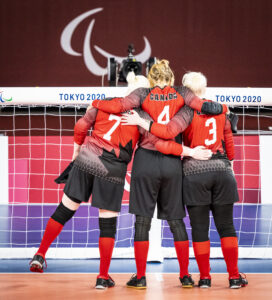
When Jenny Davey first started working at the Canadian Paralympic Committee (CPC) in 2014, she had no idea how much a fledgling research partnership would shape the work she does in the Paralympic sport system 8 years later.
“I never would have thought, ‘well, 8 years from now, I’m going to be able to pick up the phone and call this person’ or that this work would be infused in everything that I’m doing,” she says.
Davey is referring to her involvement in the Canadian Disability Participation Project (CDPP), a cross-sector network of partners working together to enhance community participation, including in sport and exercise, among Canadians with disabilities. Here, “participation” refers to both the quantity and quality of a person’s involvement in an activity.
Davey is now the CPC’s Manager of Paralympic Pathways and the community lead for the CDPP’s sport and exercise team. She works closely with Amy Latimer-Cheung, a professor in the School of Kinesiology and Health Sciences at Queen’s University and the sport and exercise team’s research lead.
Latimer-Cheung shares a similar view when she thinks back to the CDPP’s early days.
“I thought we were going to just do a lot of surveys,” she says. “I thought we would look to create a definition of quality participation, and then do a survey of athletes to understand their experience, and then maybe create a resource or 2.”
But the sheer number of relationships built, programs created, and resources developed since the CDPP launched in 2014 tell a different story. Researchers and partners from across the CDPP’s network agree that the CDPP is moving the needle when it comes to enhancing sport and physical activity participation for Canadians with disabilities.
The Canadian Disability Participation Project
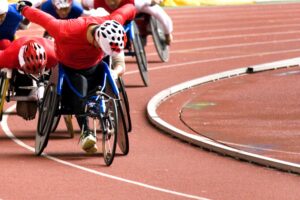 Led by Kathleen Martin Ginis, a professor in the Department of Medicine and the School of Kinesiology and Health Sciences at the University of British Columbia (Okanagan Campus), the CDPP is funded by a partnership grant from Canada’s Social Sciences and Humanities Research Council (SSHRC). SSHRC awarded the grant to Martin Ginis in 2014 for a 7-year period, then extended the grant to 2023 due to the COVID-19 pandemic.
Led by Kathleen Martin Ginis, a professor in the Department of Medicine and the School of Kinesiology and Health Sciences at the University of British Columbia (Okanagan Campus), the CDPP is funded by a partnership grant from Canada’s Social Sciences and Humanities Research Council (SSHRC). SSHRC awarded the grant to Martin Ginis in 2014 for a 7-year period, then extended the grant to 2023 due to the COVID-19 pandemic.
According to Martin Ginis, the CDPP was born out of an earlier SSHRC-funded initiative that promoted physical activity specifically for people with spinal cord injuries. “When that [initiative] ended, our spinal cord injury partners said, ‘Awesome, can we do more than just physical activity?’ And our disability partners said, ‘Awesome, can we focus on more than people with just spinal cord injury?’” she says. These conversations laid the groundwork for what became the CDPP.
The CDPP focuses on community participation in 3 areas: mobility (that is, moving about one’s community), employment, and sport and exercise. The goal of the sport and exercise team is to develop, test and implement evidence-based best-practices to increase the number of people with disabilities who participate in sport and exercise, and to improve the quality of their experiences.
“I think it’s a matter of right people, right time, right place. The sport sector is so open to the idea of quality participation,” says Latimer-Cheung, the sport and exercise team lead. “We’ve learned and continue to learn to listen to our partners… and by being open to our partners, I think that’s led us down a really amazing path,” she added.
The CDPP’s cross-sector partners include organizations that fund, offer or facilitate adapted physical activity and sport programming for Canadians with disabilities. These organizations range from community hubs, like the Abilities Centre (Whitby, Ontario) and The Steadward Centre for Personal and Physical Achievement (Edmonton, Alberta), to sport organizations that serve the national sport sector, including PowerHockey Canada, Special Olympics Canada (SOC) and the CPC.
Researchers and sport partners in the CDPP network agree that the CDPP’s commitment to community-driven research and knowledge translation are key to its success. As Latimer-Cheung puts it, “There’s nothing more rewarding than seeing the research you do put into practice and changing the way an athlete experiences sport or the way a program runs.”
Building quality participation in sport and exercise
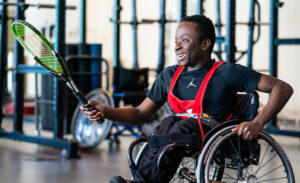 In Canada’s sport sector, the term “participation” is most commonly associated with numbers: How many people are participating in sport, how often, and for how long? While we’re so focused on quantity, we’re less likely to consider the quality of a person’s sport participation.
In Canada’s sport sector, the term “participation” is most commonly associated with numbers: How many people are participating in sport, how often, and for how long? While we’re so focused on quantity, we’re less likely to consider the quality of a person’s sport participation.
That’s where the CDPP is taking a different approach. The work of the CDPP is founded on the concept of quality participation. According to the CDPP, quality participation is achieved when a person views their involvement in sport as satisfying and enjoyable, and experiences outcomes that they consider important.
“I know we’re not the only ones talking about quality participation… but I think we are the first who have been so evidence based and deliberate and systematic in defining it and using research evidence to advance it,” says Martin Ginis.
Through building and synthesizing the evidence base focused on quality participation in sport, Latimer-Cheung’s team developed the Blueprint for Building Quality Participation in Sport for Children, Youth and Adults with a Disability. The Blueprint is a free resource that provides sport program administrators, leaders and policymakers with practical tools to design and evaluate the quality of sport programs for people with disabilities.
The Blueprint, which is based on the Quality Parasport Participation Framework, identifies 6 “building blocks” of a quality sport experience:
- Autonomy (having independence, choice and control)
- Belongingness (feeling included, accepted, and part of a group)
- Challenge (feeling appropriately tested)
- Engagement (feeling focused, absorbed or “in the zone”)
- Mastery (experiencing competence or a sense of accomplishment)
- Meaning (contributing toward a personally or socially meaningful goal)
The Blueprint also identifies strategies that program administrators, leaders and others in the sport environment can use to support the building blocks. For example, when a coach gives an athlete the option to choose the skill or technique that they feel is most important to work on during practice, the coach is supporting the athlete’s autonomy.
“The 6 building blocks seem to be quite universal across types of disability and across types of programming,” says Latimer-Cheung. “And the strategies to achieve quality don’t have to be huge changes… it’s the small things in a day that make a difference.”
In addition to the Blueprint, CDPP researchers created a tool to measure the building blocks of quality participation in a program or activity. The Quality of Participation Measure and Guide is free to download on the CDPP’s webpage.
Putting quality participation into practice
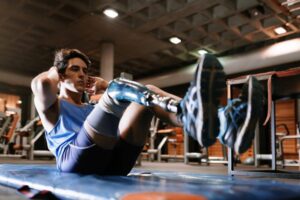 The Blueprint and related resources have become a foundational component of the work being done by the CDPP’s sport partners. From guiding program design and evaluation to setting criteria for the administration of funding opportunities, partners say the Blueprint is a helpful tool to promote quality sport programming.
The Blueprint and related resources have become a foundational component of the work being done by the CDPP’s sport partners. From guiding program design and evaluation to setting criteria for the administration of funding opportunities, partners say the Blueprint is a helpful tool to promote quality sport programming.
“One of the most useful pieces that we’ve been integrating at the Steadward Centre is the quality participation framework,” says Jen Leo, the Director of the Steadward Centre for Personal and Physical Achievement at the University of Alberta.
The Steadward Centre delivers programs in sport, physical activity and recreation for adults, youth and kids experiencing disability. Last year, the Steadward Centre asked members to rate their perceptions of the building blocks of quality participation as part of the centre’s annual program evaluations. The findings of these evaluations informed staff training, says Leo.
“Our members identified ‘challenge’ [as being important to them], which our staff didn’t identify as much. Okay, well, if that’s important for our members, how as a team can we better foster challenge?”
The Blueprint is also a go-to resource for the CPC, says Davey.
“You could be a small club using it or you could be a multisport national organization like us, depending on how high or low up the Blueprint you want to go,” she says. “I just think it’s a really good tool if you’re working in Para sport.”
While the Blueprint was initially created to inform sport programming for people with physical disabilities, a partnership with SOC helped to expand the focus to people with intellectual disabilities as well.
Tom Davies, the Director of Athlete and Coach Development at SOC, approached Latimer-Cheung about a potential partnership after she presented the quality participation framework at the Sport for Life Summit in 2019. “I just kind of walked up to them after [the presentation] because we’ve always talked about our programs being quality, but have never been able to support that, from a research or evidence base,” says Davies.
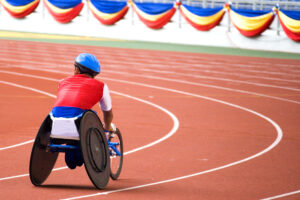 The CDPP worked with SOC to engage stakeholders in conversations about what quality participation looks like in Special Olympics Active Start and FUNdamentals programs. The CDPP also reviewed SOC’s resources for program leaders.
The CDPP worked with SOC to engage stakeholders in conversations about what quality participation looks like in Special Olympics Active Start and FUNdamentals programs. The CDPP also reviewed SOC’s resources for program leaders.
“They started really learning about Special Olympics and our programs. And they were able to define for us… where we’re hitting on the right marks based on their pillars of quality participation, and some opportunities for improvement,” says Davies.
From there, CDPP and SOC worked together to create a new Blueprint for program providers and leaders to enhance the quality of programs for participants with intellectual disabilities.
“Our partnership with SOC has been amazing,” says Latimer-Cheung. “Tom and his team have been super receptive to the work and then also provided really instrumental feedback. And, you know, we’ve learned along the way too, about how to work with partners.”
Davies agrees: “A lot of times when working with researchers we put money out, they go do the research, give us the research back, and then nothing happens. But I think with CDPP, it’s been [more collaborative].” Both partners were equally invested in the project, financially and intellectually, he says.
The CDPP’s commitment to helping SOC create quality experiences for its participants is not lost on Davies either. “There’s been a real desire to take what we found through that research and make programmatic improvements for SOC.”
Raising the profile of Para sport in Canada
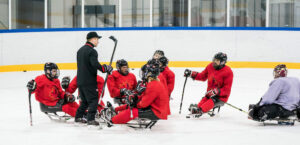 For Meghan Hines, the president of PowerHockey Canada, the opportunity to share her lived experience as a powerchair Para athlete has been a key part of her work with the CDPP. Hines is collaborating with the CDPP on a project exploring the experiences of powerchair Para athletes and program providers. The ultimate goal of the project is to get more powerchair sport programs up and running across Canada.
For Meghan Hines, the president of PowerHockey Canada, the opportunity to share her lived experience as a powerchair Para athlete has been a key part of her work with the CDPP. Hines is collaborating with the CDPP on a project exploring the experiences of powerchair Para athletes and program providers. The ultimate goal of the project is to get more powerchair sport programs up and running across Canada.
“[The CDPP researchers] have been really helpful in providing insight into how we can leverage research methodology to get the information we need to achieve our project goal,” says Hines. “Their insight, combined with our lived experience as powerchair users, has been invaluable and will truly create positive change within the Canadian Para sport landscape.”
Hines’ research with the CDPP is being used to create a “playbook” on how to run a successful powerchair sport program. The next phase of the research will involve using the playbook to pilot new powerchair sport programs across Ontario.
“At the end of the day, this project is not about research. It’s about ‘how do we create more quality powerchair sport programs, and create a better experience for our current and future powerchair Para athletes?’” she says.
While many of the CDPP’s partners are adapted sport and physical activity service or program providers, the CPC brings a different lens to its work with the CDPP. The CPC is a multi-sport service organization that works with national sport organizations to develop a sustainable Paralympic sport system in Canada.
“I think it’s a mutually beneficial relationship,” says Davey. “We certainly engage CDPP to help us with our research or when we have questions or sometimes even to help us figure out the right questions to ask. And if CDPP is looking to do certain research or they’re looking for feedback with a Paralympic lens, then we try and share back what we can.”
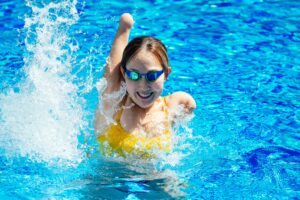 Davey likes to highlight the CDPP’s support in helping one of its network community partners, Canadian Tire Jumpstart Charities (Jumpstart), to redefine the eligibility of the Para Sport Jumpstart Fund. Davey sees it as an example of how the CDPP used research to make a small change with big impact for the program.
Davey likes to highlight the CDPP’s support in helping one of its network community partners, Canadian Tire Jumpstart Charities (Jumpstart), to redefine the eligibility of the Para Sport Jumpstart Fund. Davey sees it as an example of how the CDPP used research to make a small change with big impact for the program.
A joint initiative of the CPC and Jumpstart, the Para Sport Jumpstart Fund was a grant program designed to help community organizations remove barriers to Para sport programming for children with disabilities. Now, all Para sport, adapted sport and inclusive sport program applications are reviewed as part of Jumpstart’s Community Development Grants.
“When we were first partnering on that grant, back around 2014, 2015, we literally were not able to disperse the funds that we had because not enough organizations were eligible on the old criteria,” says Davey.
The CDPP helped CPC and Jumpstart build a case for increasing the age limit for eligible Para Sport programs from 18 to 25. The CDPP also helped them to expand the definition of “barriers” beyond strictly financial need. After implementing these changes, demand for the program soared. As Davey put it: “We went from not being able to get the money out to huge demand and huge impact.”
The evolution of the CPC’s partnership with the CDPP over the last 8 years has been a highlight of Latimer-Cheung’s involvement in the CDPP.
“The CPC has always been great to reach out to ask for the latest and greatest findings, but now they’re also reaching out with their own research ideas,” she says. It’s something she hopes more organizations will think about doing in the future.
“I want sport organizations to know that they’re reaching researchers hungry to work with them. And we always find their ideas really exciting and interesting.”
Supporting an inclusive sport system, from playground to podium
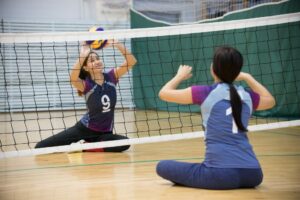 The CDPP’s sport and exercise team is also pushing boundaries when it comes to studying physical activity and sport participation in new and non-traditional contexts, like on the playground.
The CDPP’s sport and exercise team is also pushing boundaries when it comes to studying physical activity and sport participation in new and non-traditional contexts, like on the playground.
Kelly Arbour-Nicitopoulos is an associate professor studying disability and physical activity at the University of Toronto. She’s leading a CDPP project that explores the playground experiences of Canadian children with disabilities and their families, including how physical educators and rehabilitation specialists can use playground spaces.
Arbour-Nicitopoulos has been working with Jumpstart since 2019 to help evaluate the impact of the playgrounds built through its Inclusive Play initiative. The initiative works in partnership with local municipalities to bring large-scale inclusive infrastructure to communities across Canada, in an effort to ensure children of all abilities have access to recreational infrastructure.
“Families are having positive experiences from opportunities [for children with disabilities] to be involved in play on the playground. But what’s interesting is that there are still challenges in the surrounding environment,” says Arbour-Nicitopoulos.
In other words, while the playgrounds are built to be inclusive, getting to the playground might be more difficult. For example, while Jumpstart works with municipal partners to try to ensure accessible parking spaces, pathways and washroom facilities, there continues to be room for improvement with regard to the accessibility of resources surrounding the playgrounds. By communicating these findings back to Jumpstart and the communities with these playgrounds, Arbour-Nicitopoulos hopes to create a more inclusive playground experience “from the moment a parent or child wants to go to the playground” to when they arrive back home.
Arbour-Nicitopoulos and her team have also identified 13 recommendations for how to design inclusive playgrounds based on an extensive review of the academic literature. She is working with partners to create evidence-informed resources that will put these recommendations into practice.
“We have been creating evidence-based resources with The Steadward Centre and colleagues at Holland Bloorview [Kids Rehabilitation Hospital] to support not only the building of more inclusive and accessible playgrounds, but also training on inclusive play practices to maximize return-on-investment of playground spaces and create quality play experiences for children and youth with disabilities,” she says.
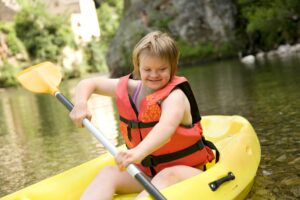 Another way that the CDPP is working to support inclusive sport and physical activity programs is through advocacy and awareness.
Another way that the CDPP is working to support inclusive sport and physical activity programs is through advocacy and awareness.
“A family can’t participate in a physical activity program if they don’t know it exists, or if they don’t know whether or not it meets their child’s needs,” says Rebecca Bassett-Gunter, an associate professor in the School of Kinesiology and Health Science at York University.
Bassett-Gunter’s contributions to the CDPP center on evidence-informed practices to promote physical activity to families of children with a disability. These practices include everything from what a message says to how that message is shared with its target audience.
A tangible outcome of Bassett-Gunter’s recent work has been the development of 5 evidence-informed recommendations for community-based organizations. The recommendations are intended to help organizations in their efforts to promote physical activity among children with disabilities through sharing information with parents.
“We have gone through this process of looking at our own research evidence, and then going through a more rigorous process involving 31 different stakeholders to come to a consensus on recommendations that we can give to community-based organizations,” says Bassett-Gunter.
Engaging stakeholders in the process helped to ensure the recommendations would be relevant and useful for community-based organizations. But working with 31 different stakeholders posed challenges of its own.
“You can imagine that ParticipACTION’s needs are really different than the Toronto Accessible Sports Council or the Steadward Centre in Alberta,” says Bassett-Gunter. “But it was really important to have all those voices involved.”
“There’s no downside to bringing Para sport into the community”
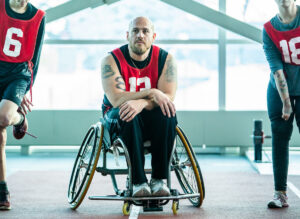 Since 2014, the CDPP sport and exercise team has partnered with over 70 organizations, published nearly 60 peer-reviewed papers, and created more than 100 resources, toolkits and knowledge translation bulletins. While the grant that funds it will expire in 2023, Latimer-Cheung is leading the charge to obtain new funding to support the CDPP’s sport and exercise initiatives.
Since 2014, the CDPP sport and exercise team has partnered with over 70 organizations, published nearly 60 peer-reviewed papers, and created more than 100 resources, toolkits and knowledge translation bulletins. While the grant that funds it will expire in 2023, Latimer-Cheung is leading the charge to obtain new funding to support the CDPP’s sport and exercise initiatives.
“One of the cool things is that because it’s been such a long grant, it’s given us time to really establish long term relationships,” says Leo, who was first contacted about partnering with the CDPP during the grant writing process in 2013. “I feel like even if CDPP stopped tomorrow, we would continue working together because it is such a mutually beneficial collaboration.”
The group will continue to develop new and existing relationships to enhance the quantity and quality of sport and physical activity participation among Canadians with disabilities, building on the knowledge it has gathered and translated over the last 8 years.
“The strategies aren’t rocket science, but the way that [the CDPP researchers] present them and explain things and the fact that it is being presented by researchers and is evidence based, I think gives it a little bit more weight,” says Davies. “I think just being able to get those strategies and tools out there has created potential for more inclusive sport environments,” he adds.
Hines echoes Davies’ sentiment. “There’s no downside to bringing Para sport into the community. It may feel like a big undertaking, but with the right tools and strategies, like those provided by the CDPP, it is more than possible,” she says.
Making progress in the areas of inclusion and equity often requires stepping outside of your comfort zone, but the CDPP has shown what a difference that can make. As Bassett-Gunter puts it:
“I think people are scared of getting things wrong in the area of inclusion. And you know, I think it’s the willingness to learn and try and work with the people in your community to do the best that you can, that’s really what we need to focus on.”
Recommended resources
Quality of Participation Measure and Guide
Inclusive Playgrounds Resource
All of the CDPP’s resources are freely available at cdpp.ca.
About the Author(s)
Veronica Allan, Ph.D., is the Manager, Research and Innovation at SIRC. In this role, she leads SIRC’s research and evaluation initiatives. She also solicits, supports and curates content from researchers, experts and thought leaders to mobilize knowledge for Canada’s sport and physical activity sector. Her experiences as a researcher, journalist and athlete have equipped her with a unique skillset and passion for data, storytelling and sports!
References
Brown, D., Ross, T., Leo, J., Buliung, R., Shirazipour, C., Latimer-Cheung, A.E., Arbour-Nicitopoulos, K. P. (2021). A scoping review of evidence-informed recommendations for designing inclusive playgrounds. Frontiers of Rehabilitation Sciences, 2:664595. http://doi.org/10.3389/fresc.2021.664595
Evans, M. B., Shirazipour, C. H., Allan, V., Zanhour, M., Sweet, S. N., Ginis, K. A. M., & Latimer-Cheung, A. E. (2018). Integrating insights from the parasport community to understand optimal Experiences: The Quality Parasport Participation Framework. Psychology of Sport and Exercise, 37, 79-90. https://doi.org/10.1016/j.psychsport.2018.04.009
Martin Ginis, K. A., Evans, M. B., Mortenson, W. B., & Noreau, L. (2017). Broadening the conceptualization of participation of persons with physical disabilities: a configurative review and recommendations. Archives of Physical Medicine and Rehabilitation, 98(2), 395-402. https://doi.org/10.1016/j.apmr.2016.04.017
The information presented in SIRC blogs and SIRCuit articles is accurate and reliable as of the date of publication. Developments that occur after the date of publication may impact the current accuracy of the information presented in a previously published blog or article.
